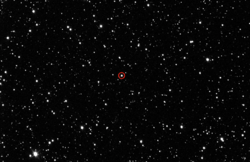Astronomy:KIC 9832227
| Observation data Equinox J2000.0]] (ICRS) | |
|---|---|
| Constellation | Cygnus |
| Right ascension | 19h 29m 15.950s[1] |
| Declination | +46° 37′ 19.86″[1] |
| Apparent magnitude (V) | 12.27 – 12.46[2] |
| Characteristics | |
| Spectral type | K2III/IV[3] |
| Variable type | Eclipsing[4] |
| Astrometry | |
| Proper motion (μ) | RA: −9.505[1] mas/yr Dec.: −5.718[1] mas/yr |
| Parallax (π) | 1.5798 ± 0.0134[1] mas |
| Distance | 2,060 ± 20 ly (633 ± 5 pc) |
| Orbit[5] | |
| Period (P) | 0.4282579 days |
| Semi-major axis (a) | 2.992 R☉ |
| Inclination (i) | 53.2° |
| Periastron epoch (T) | 2455688.49913 |
| Details[5] | |
| A | |
| Mass | 1.395 M☉ |
| Radius | 1.581 R☉ |
| Luminosity | 2.609 L☉ |
| Surface gravity (log g) | 4.19 cgs |
| Temperature | 5800 K |
| Rotational velocity (v sin i) | 149.7 km/s |
| B | |
| Mass | 0.318 M☉ |
| Radius | 0.830 R☉ |
| Luminosity | 0.789 L☉ |
| Surface gravity (log g) | 4.10 cgs |
| Temperature | 5920 K |
| Rotational velocity (v sin i) | 84.7 km/s |
| Other designations | |
| Database references | |
| SIMBAD | data |
| KIC | data |
KIC 9832227 is a contact binary star system in the constellation Cygnus, located about 2,060 light-years away. It is also identified as an eclipsing binary with an orbital period of almost 11 hours.[4]
Incorrect 2022 merger prediction
In 2017, the system was predicted to result in a merger in 2022.2 (± 0.6 years), producing a luminous red nova (LRN) reaching an apparent magnitude of 2,[7] or about the brightness of Polaris, the North Star. The LRN would remain visible to the naked eye for roughly a month. The merger of the two stellar cores was predicted to give birth to a new, hotter, more massive main-sequence star. However, a reanalysis of the data in September 2018 revealed that the prediction had been based on a wrongly timed observation, negating the predicted merger.[8][9][10]
The period of the variations in KIC 9832227 has been observed to be growing shorter since 2013, leading to the prediction of the merger in or around 2022.[11] In September 2018, it was announced that the original prediction was based on a dataset which timing had been erroneously offset by 12 hours—an error which appeared to exaggerate the decay rate of the orbital period. Correcting for the error shows that the period had actually been increasing up to about 2008. The cause for the period variation is still unknown, but it was determined the system would not be merging at the predicted time.[8][9][12]
See also
References
- ↑ 1.0 1.1 1.2 1.3 1.4 Vallenari, A. et al. (2022). "Gaia Data Release 3. Summary of the content and survey properties". Astronomy & Astrophysics. doi:10.1051/0004-6361/202243940 Gaia DR3 record for this source at VizieR.
- ↑ "ASAS J192916+4637.3". AAVSO. http://www.aavso.org/vsx/index.php?view=detail.top&oid=169823.
- ↑ Frasca, A.; Molenda-Żakowicz, J.; De Cat, P.; Catanzaro, G.; Fu, J. N.; Ren, A. B.; Luo, A. L.; Shi, J. R. et al. (2016). "Activity indicators and stellar parameters of the Kepler targets. An application of the ROTFIT pipeline to LAMOST-Kepler stellar spectra". Astronomy and Astrophysics 594. doi:10.1051/0004-6361/201628337. Bibcode: 2016A&A...594A..39F.
- ↑ 4.0 4.1 Kinemuchi, Karen (2013-10-01). "To Pulsate or to Eclipse? Status of KIC 9832227 Variable Star". arXiv:1310.0544 [astro-ph.SR].
- ↑ 5.0 5.1 Molnar, Lawrence A.; Van Noord, Daniel M.; Steenwyk, Steven D.; Spedden, Chris J.; Kinemuchi, Karen (2015). "A prediction of a luminous red nova eruption". American Astronomical Society 225 (225): 415.05. Bibcode: 2015AAS...22541505M. http://www.calvin.edu/academic/phys/observatory/MergingStar/MolnarEtAl2017.pdf.
- ↑ "MAST: Barbara A. Mikulski Archive for Space Telescopes". Space Telescope Science Institute. https://mast.stsci.edu/portal/Mashup/Clients/Mast/Portal.html.
- ↑ Molnar, Lawrence A.; Van Noord, Daniel; Kinemuchi, Karen; Smolinski, Jason P.; Alexander, Cara E.; Kobulnicky, Henry A.; Cook, Evan M.; Jang, Byoungchan et al. (2017). "KIC 9832227: A red nova precursor". American Astronomical Society 229: 417.04. Bibcode: 2017AAS...22941704M.
- ↑ 8.0 8.1 Molnar, Lawrence A. (7 September 2018). "Supplementary material to Calvin College press release "Team of researchers challenge bold astronomical prediction", September 7, 2018". http://www.calvin.edu/academic/phys/observatory/MergingStar/2018Update.html.
- ↑ 9.0 9.1 Kucinski, Matt (7 September 2018). "Team of researchers challenge bold astronomical prediction". https://calvin.edu/news/archive/team-of-researchers-challenge-bold-astronomical-prediction.
- ↑ Parks, Jake (7 September 2018). "Two stars will NOT merge and explode into red fury in 2022". http://www.astronomy.com/news/2018/09/two-stars-will-not-merge-and-explode-into-red-fury-in-2022.
- ↑ Carlisle, Camille (6 January 2017). "Paired Stars in Cygnus En Route to Merger". Sky and Telescope. http://www.skyandtelescope.com/uncategorized/stars-en-route-to-merger/.
- ↑ Socia, Quentin J.; Welsh, William F.; Short, Donald R.; Orosz, Jerome A.; Angione, Ronald J.; Windmiller, Gur; Caldwell, Douglas A.; Batalha, Natalie M. (11 September 2018). "KIC 9832227: Using Vulcan Data to Negate the 2022 Red Nova Merger Prediction". Astrophysical Journal Letters 864 (2): L32. doi:10.3847/2041-8213/aadc0d. Bibcode: 2018ApJ...864L..32S.
External links
- Molnar, Lawrence (4 January 2017). "Prediction of a Red Nova Outburst in KIC 9832227". Calvin College Group. http://www.calvin.edu/academic/phys/observatory/MergingStar/MolnarEtAl2017.pdf.
- Knapton, Sarah (6 January 2017). "Spectacular collision of suns will create new star in night sky in 2022". The Telegraph. https://www.telegraph.co.uk/science/2017/01/06/spectacular-collision-suns-will-create-new-star-night-sky-2022/.
- Byrd, Deborah (6 January 2017). "Star predicted to explode in 2022". EarthSky Communications. http://earthsky.org/space/star-predicted-to-explode-in-2022.
- Masi, Gianluca (11 January 2017). "Star merging in KIC 9832227: a possible once-in-a-lifetime event". http://www.virtualtelescope.eu/2017/01/11/star-merging-in-kic-9832227-a-possible-once-in-a-lifetime-event/.
 |



